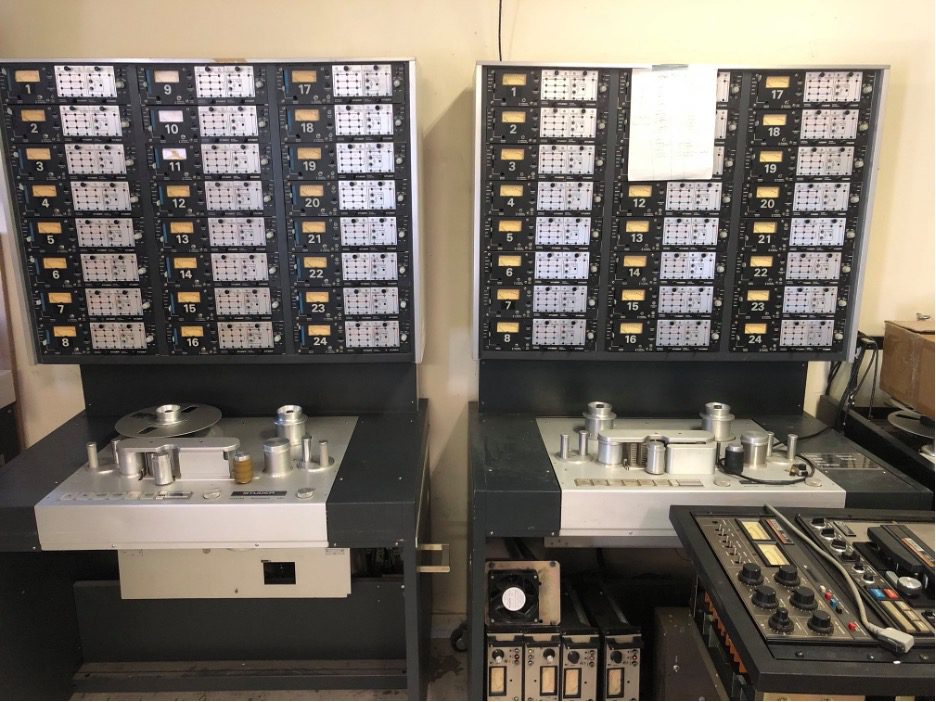Two Studer A80s in my shop, circa 2021. The deck on the left is a MK IV, and was sold to a studio in Delaware in 2022. The deck written about here is on the right, and is the Mushroom Studios deck – an early MKII.
Introduction
The Studer A80 series of tape decks needs no introduction to veteran studio engineers, musicians, and other studio ‘rats’. With its stellar sound and overall performance, the A80 was a staple in all higher end recording studios, starting in 1970 when it was introduced. Countless major albums were recorded on the A80 series of decks, which ranged from ¼” full track mono machines to 2” 24 tracks, and almost any variation in-between. The A80 even came in a video layback format which would record audio on the edge of a 1” video tape.
Four versions of the A80 were manufactured, with the MKI coming out in 1970, and the final MKIV production run ceasing in 1989.
As with all Revox and Studer decks, the A80 was known for its flat frequency response. What you fed into the deck is exactly what you got out of the machine. With little coloration, the frequency response is a ruler-flat line from around 40Hz to over 22Khz. This was all depending on the calibration, tape used, and the head condition. Everything in the Studer A80 was overbuilt and designed to be run 24/7, as many top end studios were back in the heyday of large recording studios.
Mushroom Studios/Records
The history of this machine is a bit interesting, as found on several online articles. Mushroom Studios was located on West 6th Avenue, just outside of downtown Vancouver. Mushroom was originally called Can-Base, renamed later to Mushroom Studios.
Many international and Canadian bands recorded at Mushroom Studios over the years, most famously the early Heart records which brought fame to the studios, but also Loverboy, Skinny Puppy, Sarah McLachlan and BTO.
An interesting album was also recorded at Mushroom. That being the one hit wonder band,called the Incredible Bongo Band, with their debut album called Bongo Rock. The single ‘Apache’ was released in 1973 which was a hit. I remember walking to elementary school hearing it on my pocket AM radio, and later I found it on a KTel record that I have to this day. The song was a catchy instrumental, and was recorded at Mushroom to take advantage of the Canadian content laws according to Wikipedia. The band released a second album that didn’t chart as well as the first one, and since the musicians were all studio session musicians, the band disbanded. The song would have been forgotten had it not been for rap and hip-hop. In the late 1980s and early 1990s, the DJs for these new groups were constantly seeking drum beats to sample. They stumbled across the Apache song which had a couple of drum breaks within the song. This song then went on to be the most sampled song in hip-hop and rap history, according to the documentary ‘Sample This’ which came out in 2012. (A Tubi link is below, it can also be found on Netflix)
https://tubitv.com/movies/699105/sample-this?=undefined&startPos=7
This Studer A80 can be seen in the documentary, at 1:14:50 above, but watch the whole documentary – it’s short, and interesting to anyone in the music or audio world.
When Mushroom Studios was purchased by Robert Darch in 2006, he renamed it Hippo West, and eventually moved the deck to the building that Little Mountain Sound was located in. He also moved this deck over to that location as well. This Studer A80 can also be seen in the documentary ‘Little Mountain, Big Sound’, released in 2023, and is available on YouTube:
https://www.youtube.com/watch?v=MlnsoSmSmPQ&t=4s
The deck can be seen in the Little Mountain Studios at 25:40, and then in the loading bay a few years later when I purchased it, at 31:07 in the documentary. I also purchased the A800 2 years later sitting next to the A80, but that’s a different story that will appear on this website once I work on it.

Some time in 2020, I received a phone call from Rob Darch, the owner of Hipposonic (the final name of Hippo West Studios, now located in the former Little Mountain building), asking if I wanted to purchase the Studer A80. Having never worked on one, of course I said yes and drove down with a 1 ton van to pick it up. I received the deck in exactly the condition shown in the Little Mountain documentary at 31:07, with the 8 ½ X 11 white paper taped to the front of it. This piece of paper was put there by Corey Dixon, a Vancouver studio tech, which stated the operating condition of each channel.
Once in my shop, it turned out that several channels of audio were defective, and when I first turned on the deck, it had only the rewind function working – play, record and FF were dead. As is typical, a bunch of VU meter lights were burned out, as were the tiny (and insanely expensive!) incandescent ‘record’ and ‘ready’ bulbs. The deck also had the optional Varispeed installed in it, above the capstan speed/power switch.
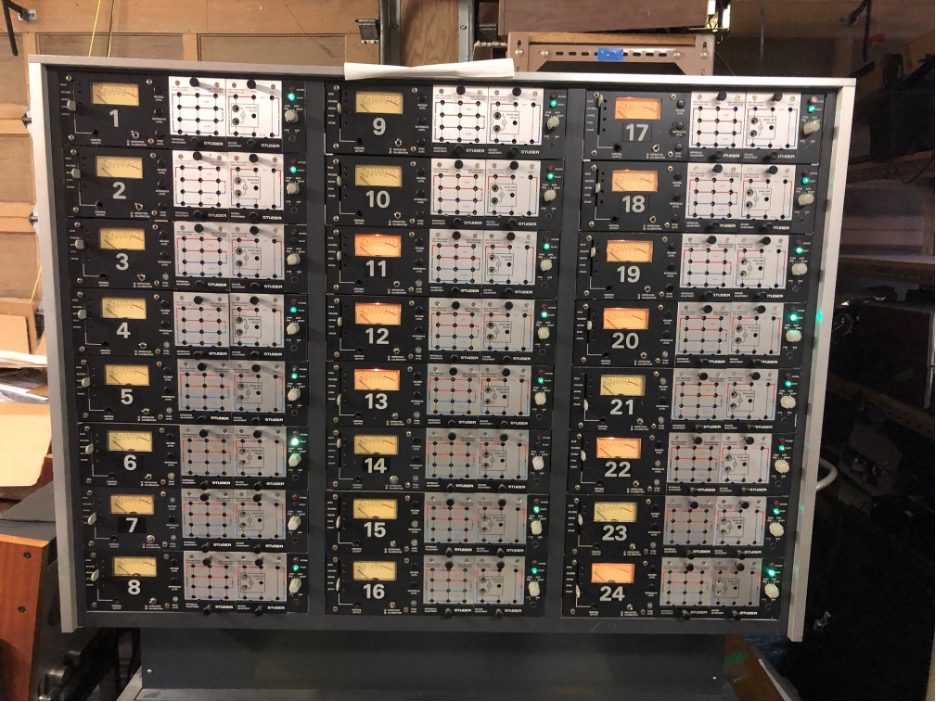
Restoration
While I started on the massive restoration project back in 2020, things unfortunately got sidetracked and I ended up recapping most of the audio channels. I became busy with other work as the website gained popularity, and simply put the deck aside. I also ended up purchasing a later model Studer A80 MkIV, and decided that since I didn’t know the history of the second deck, I restored it first before working on the Mushroom deck. The Mk IV ended up selling in 2021.
Each audio channel has 16 capacitors that are known to short out, as they are the infamous Frako brand of capacitors. Indeed, 8 channels of this A80 MKII had shorted caps in the main power supplies causing a fuse to blow, and thus a dead audio channel. In the 1980s, digital recording was favoured, and most studios allowed the maintenance to lapse on these large decks. Thus, when a channel blew, the deck turned into a 23 channel deck. A few months later when another couple of channels went out, it turned into a 21 channel deck, so indeed when I got the deck, it was an 18 channel deck.
The intelligent and fabulous design of the A80 cannot be understated. Each audio channel, as well as the bulk of the transport electronics is modular, and the audio channels can be ‘hot swapped’ (no need to turn off the power) . This meant a tech could work on the deck while it was being used in a recording session. Many studios kept a couple of spare audio channels and transport cards so that swaps could be made quickly.
In addition, each audio channel had its own power supply, so if one channel failed, the rest wouldn’t be affected. The VU meter lights are 30 volt incandescent bulbs, and if one side of the dual 12 volt power supply went out, the bulb behind the VU meter would dim significantly. This indicated a blown fuse, and most likely a capacitor failure in that channel.
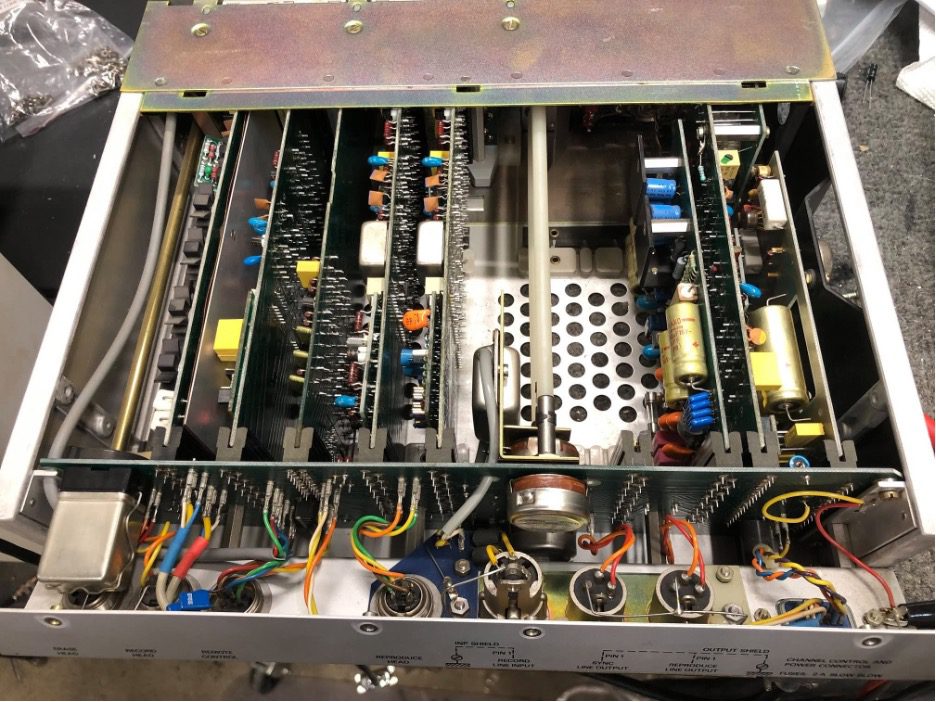
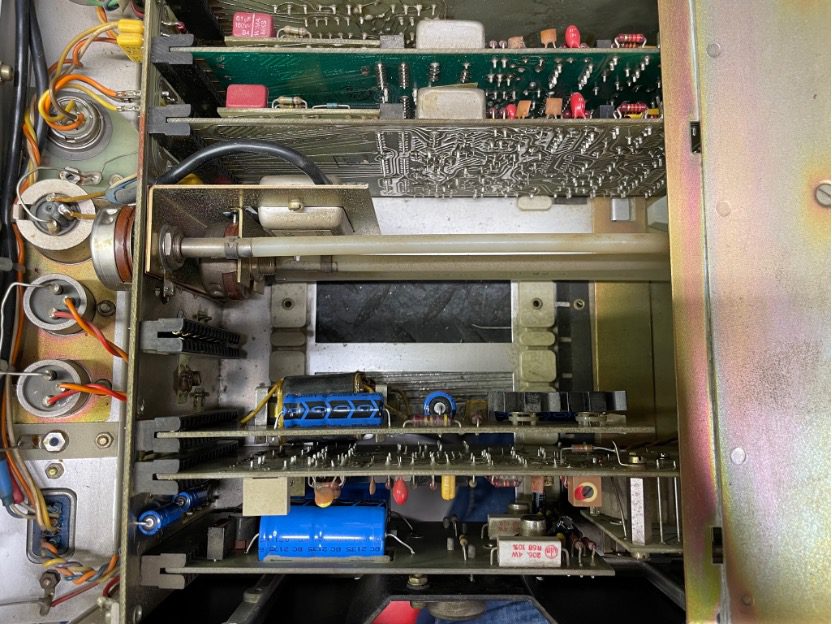
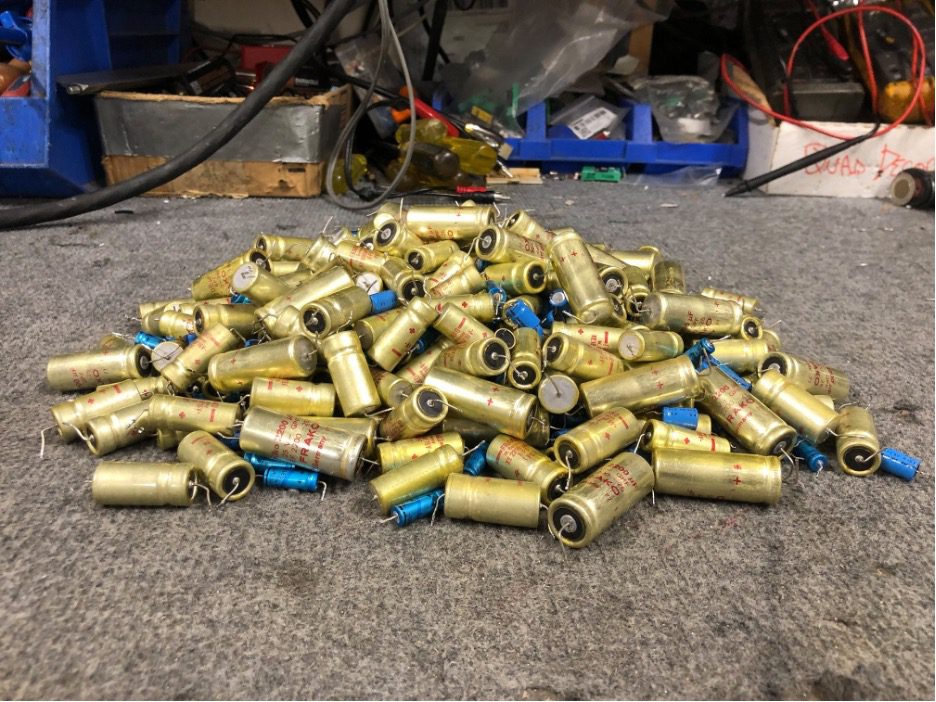
The audio channels were recapped back in 2020 and 2021. Then the deck sat there for 3 years untouched, and under a moving blanket until late 2024, At this point, we stopped taking in consumer tape decks to allow us more time to work on our own decks such as this one.
Part 2 …
Audio Electronics rebuilding
Continuing with the audio module rebuilding, each module has two tiny 28 volt bulbs for the ‘record’ and ‘ready’ lamps. Despite trying many replacement bulbs, including some 5V ones, we haven’t found the exact replacement for these. There are a couple of online sellers that do sell them, but at $5.00 US per bulb, it gets expensive to bring all of them to working condition.
We therefore decided to change them to LEDs, that will last the life of the deck. Normally we despise LEDs taking the place of incandescent bulbs, as they give a cold look compared to the original, however it’s always a case of cost vs performance, and with the LED’s being around $2.00 each, the choice was obvious.

We have written an article up on the website about how to change the incandescent bulbs to LED:
Converting the Record and Ready Lights to LED in a Studer A80
Similarly, we changed out the incandescent bulb for the end of tape sensor at the head block to LED. This procedure is a bit more advanced, as we’ve used copper tubing to insert the LED replacement into, similar to the original design of the Studer. On occasion, the photocell pickup goes bad, and we’ve had to change those as well to a modern day equivalent.
Next up was the transport. The transport uses stud mount Frako brand capacitors as the main filter caps. While failure of these is relatively rare compared to the smaller Frakos on the various PC boards, we decided to change them out on this deck. (the silver one in the middle of the picture has yet to be changed out) The entire power supply drops out as a single piece with the removal of 4 large bolts from the top of the transport. The power supply can then easily be worked on at a workbench.

To our surprise when we got in our first A80 several years ago, is that there’s no motherboard behuind the transport electronics. Instead, the wiring is point to point between the modules, as you can see if you look past the above transport modules. It’s a literal rats nest of wiring, however the wiring is solid, and given that the transport does vibrate, especially when running 2” tape in fast wind modes, no motherboard solder joints would have withstood such torture, so the hard wiring is justified.
The one thing to keep in mind with pretty much any Studer is that they were made to be field serviceable. Everything unbolts and unplugs easily, as you’ll see in a future website article, about another A80 24 track that had a heavy pallet stacked on it during shipping. There’s not a straight corner of the transport or the electronics frame as a result. We just found (March of 2025) a stripped A80 24 track on Reverb, with no electronics cards, but a straight transport and electronics frame, so we’ll make one solid deck out of the 1 ½ we will have here by the end of March!
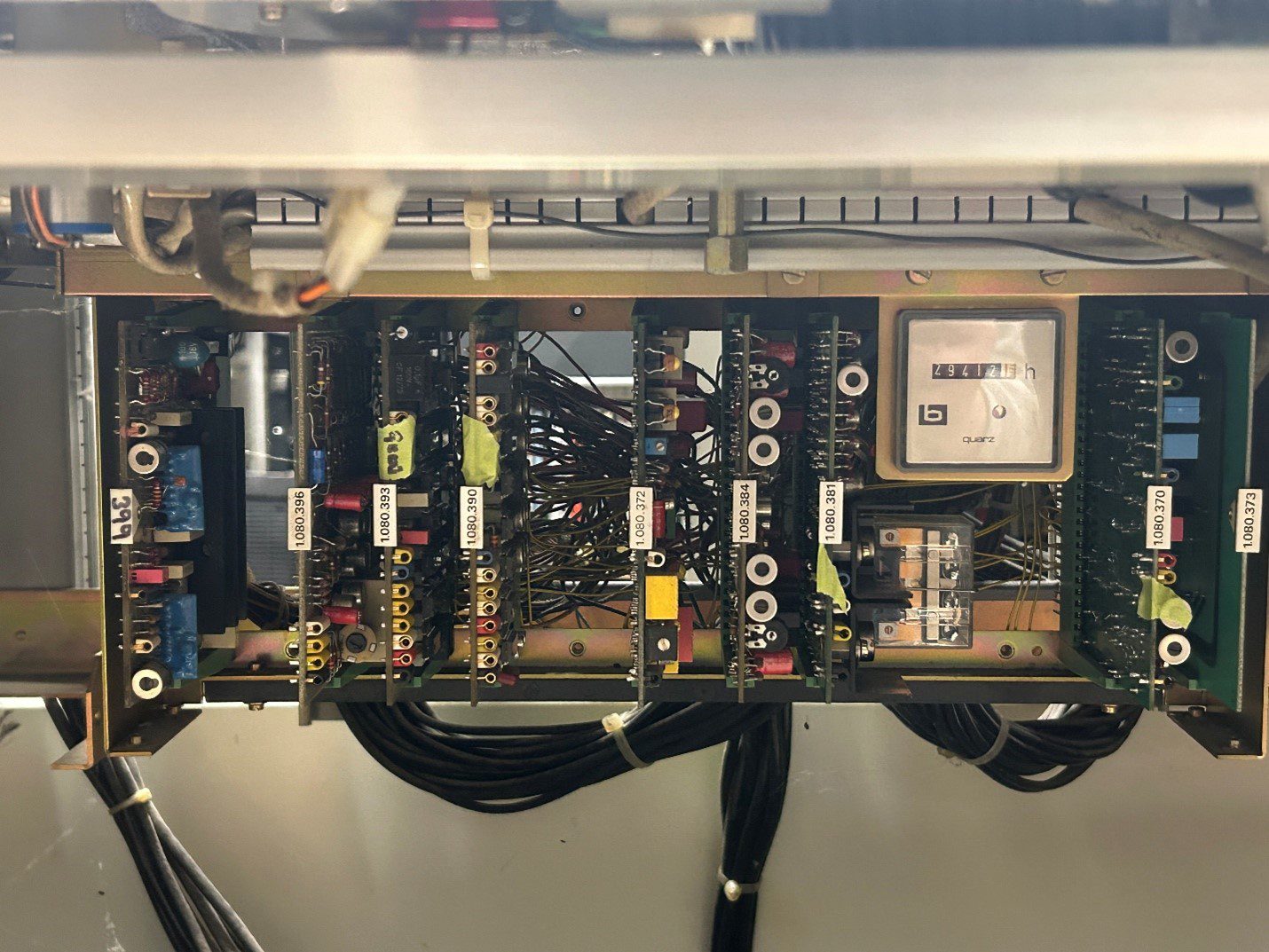
A view of the transport electronics. The yellow painter’s tape was put on several modules by us, so that we could identify working boards while troubleshooting the chassis.
All the electrolytic capacitors were changed on each of the transport boards as well, and the exploding Rifa caps were the first thing replaced, even before powering the deck up.
While the transport and electronics is reliable, these decks can and will fail. Careful troubleshooting of the circuits and boards is crucial, as is the setup of the transport and electronics as well. Studer did manufacture PC board extenders, that bring the boards out for easier troubleshooting. The transpot flips up 90 degrees, for easy access to the motors and other transport components.
Stay tuned for part 3 coming soon!

